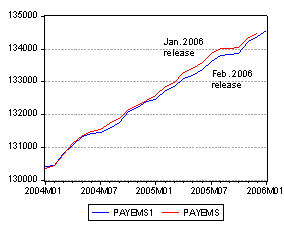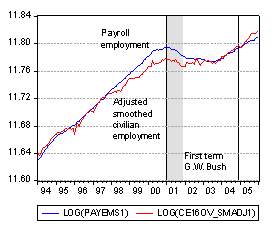(Revised) Employment growth is up, but (revised) employment is down.
There were several pieces of interesting news in the Employment situation report for January. Not only was employment growth up, at 193,000 in January; previously reported growth was up as well. My colleague Jim Hamilton has some thoughts on the report. Here I discuss some related aspects of the new figures, placing them in broader context.
In particular, I was intrigued by the report of more rapid growth, so I plotted the data, and found that, indeed growth was more rapid, but the revised level of employment was, as Jim notes, lower than before. This can be seen in this graph:

So the annual benchmark revision placed actual payroll employment lower.(Late addition: pgl at Angry Bear seems to have made a similar observation). Indeed, as pointed out in the Washington Post article, the benchmark revision knocked out the miniscule job gain for the first Bush Administration. By December 2004, payroll employment was -76,000 less than in January 2001. Both the payroll employment series, and the household survey based employment series adjusted to conform to the establishment survey coverage, are plotted in the figure below.

Interestingly, most business commentary seems to take the latest employment figures as indicating robust labor market conditions. To quote Secretary of Treasury John Snow’s comments on the report:
“Today we have terrific news that the unemployment rate has now dropped to 4.7 percent– the lowest it has been since July of 2001– and that 193,000 new jobs were created in January. On average, 200,000 jobs have been created each month over the past three months. People who have been unemployed are finding it easier and easier to find jobs. These numbers are a positive indicator that the American economy continues to hold great promise for all Americans who are seeking employment.”
In addition to recalling the fact that the unemployment rate depends upon the number of unemployed and the participation rate (as noted by Angry Bear), I think it’s still useful to compare the employment growth in this recovery against that in previous recoveries.

Not only has employment growth been unnaturally low in this recovery, it has been — and remains — low relative to even the post-1991 recovery, which was itself marked by slow job creation. The low employment growth is especially marked given the pace of GDP growth (as pointed out in an earlier post on this subject). Keeping these new data in context might be useful in assessing whether the labor market is doing well or not. (In addition, as Julie Hotchkiss at the Atlanta Fed has noted, the unemployment rate adjusted for discouraged workers is probably higher than the reported — by 0.4 percentage points in December 2004). That being said, I concur with Jim’s assessment that sustained growth in employment over the past few months does suggest that 2006q1 GDP growth will be more vigorous than that reported for 2005q4.
It seems that the story of the US economy over the last couple of decades is that the jobs are gradually moving to India and China where labor is cheaper, and we are borrowing to maintain our lifestyle in the face of this trend. Each recession squeezes out more jobs and fewer and fewer of them come back each time. On the evidence of the last graph above, the trend has been accelerating.
It would seem rather hard to do much about this until labor/exchange rates reduce the enormous cost advantage of workers in Asia. I guess the other alternative would be, a la France and Germany, to do a lot less borrowing and have anemic growth until the rates equalize.
Are there any significant changes in the rate of immigration for this period compared with 1991-95?
Stuart Staniford: Nice observation — it’s clear that there are both cyclical and secular trends present in the data. But there is nothing in shifting comparative advantage which implies that job creation should be slower than before. Rather, the evolution of comparative advantage should affect the terms at which goods produced here exchange for goods produced abroad.
On the other hand, one could imagine the changing relative costs of labor versus capital (and the cost of capital has decreased in recent years due to tax policies and monetary policy) could be important.
Ion D: I can’t really say I know the answer to you question. I suspect that changes in legal and illegal immigration rates probably explain why the payroll and the estimated over-16 civilian employment figures have diverged.
It is worth reviewing a recent study by Dean Baker et. al. at http://www.cepr.net finding that the Current Population Survey on which monthly household data are based may in fact be understating unemployment rate by 1.4%. They claim that the persistent rise in non-response rates are heavily tilted toward greater rates of non-response by those who are not employed. Even if half right, the study lends more credence to the notion of an alarmingly meagre employment recovery and a far greater number of officially unemployed and perhaps as well of marginally attached/discouraged/stopped actively looking but want work than are being reflected in the CPS.
With respect to the response to Stuart S., how would you expect the terms of trade adjust in the presence of a more-or-less fixed exchange rate? Possibly through differential inflation in tradables, but that doesn’t appear to be significant right now.
It seems clear that the current exchange rate is being sustained not by any current or prospective export of goods from the US, but by US primacy in the export of debt. While that persists, and given wages being sticky downward, I don’t see why US labor demand wouldn’t be depressed.
As many other people have said, this arrangement can’t last forever, but until it breaks down I would expect weaker-than-historical wage and employment growth.
Eric Glynn: Thanks for the reference to the CEPR.NET report. I suspect that this is yet another reason to favor the payroll employment series over the household based surveys.
Matt Wilbert: I think I understand your point — namely that China and hence the rest-of-East Asia implicitly pegs to the the US dollar. But for the multilateral US balance of trade, over time the multilateral real exchange rate is going to be the key determinant of the terms of trade. On this count, there has been plenty (although in my opinion insufficient) variation over the past four years, including the 15% broad depreciation and the subsequent 5% appreciation (Fed chain weighted broad index). On the other hand, if you’re saying that different composition of output due to a different fiscal/monetary policy mix, then I think we’re in fundamental agreement.
THE TAX CUTS ARE WORKING
. . . unless you care about jobs. PGL at Angry Bear Barry Ritholtz at The Big Picture Menzie Chin at Econobrowser (here too) Labor market genius Jared Bernstein (Mama MaxSpeak: “How come that Jared Bernstein person always gets quoted…
Menzie Chinn: You are welcome. Note that the CEPR report claims a 1.4% gap between the CPS *employment rate* and the actual employment rate. My error in the comment. The CEPR report by John Schmitt & Dean Baker is here: http://cepr.net/publications/undercounting_cps_2006_01.pdf.